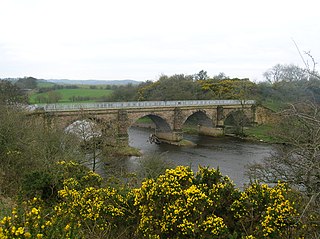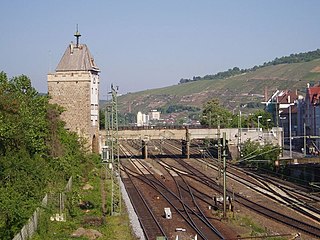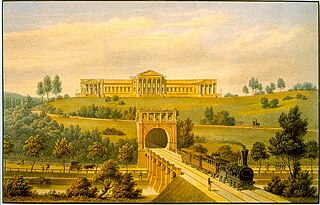
The Neckar Viaduct at Weitingen is a bridge that crosses the valley of the River Neckar, near the town Horb am Neckar. The bridge is an important part of motorway A81's section Stuttgart - Singen.

The Neckar Viaduct at Weitingen is a bridge that crosses the valley of the River Neckar, near the town Horb am Neckar. The bridge is an important part of motorway A81's section Stuttgart - Singen.
The bridge has an overall length of 900 meters, spans of 234-134-134-134-264 meters and a height of 125 meters above ground. The width of the bridge deck amounts to 31.5 meters.

The structure is a steel box girder, which is 10 meters wide and 6.10 meters tall. [1] A characteristic are the approach spans, which are cable trussed beams, to avoid pylons in the valley slopes. The south span is 264 meters long.
The bridge was handed over to the public in 1978. Directly east of the bridge is a 110 kV power line, hung on high anchor masts 70 meters high, crosses the Neckar Valley from Eutingen to St. Georgen.

The Neckar is a 362-kilometre-long (225 mi) river in Germany, mainly flowing through the southwestern state of Baden-Württemberg, with a short section through Hesse. The Neckar is a major right tributary of the Rhine. Rising in the Schwarzwald-Baar-Kreis near Schwenningen in the Schwenninger Moos conservation area at a height of 706 m (2,316 ft) above sea level, it passes through Rottweil, Rottenburg am Neckar, Kilchberg, Tübingen, Wernau, Nürtingen, Plochingen, Esslingen, Stuttgart, Ludwigsburg, Marbach, Heilbronn and Heidelberg, before discharging on average 145 m3/s (5,100 cu ft/s) of water into the Rhine at Mannheim, at 95 m (312 ft) above sea level, making the Neckar its 4th largest tributary, and the 10th largest river in Germany. Since 1968, the Neckar has been navigable for cargo ships via 27 locks for about 200 kilometres (120 mi) upstream from Mannheim to the river port of Plochingen, at the confluence with the Fils.

A cable-stayed bridge has one or more towers, from which cables support the bridge deck. A distinctive feature are the cables or stays, which run directly from the tower to the deck, normally forming a fan-like pattern or a series of parallel lines. This is in contrast to the modern suspension bridge, where the cables supporting the deck are suspended vertically from the main cable, anchored at both ends of the bridge and running between the towers. The cable-stayed bridge is optimal for spans longer than cantilever bridges and shorter than suspension bridges. This is the range within which cantilever bridges would rapidly grow heavier, and suspension bridge cabling would be more costly.

A viaduct is a specific type of bridge that consists of a series of arches, piers or columns supporting a long elevated railway or road. Typically a viaduct connects two points of roughly equal elevation, allowing direct overpass across a wide valley, road, river, or other low-lying terrain features and obstacles. The term viaduct is derived from the Latin via meaning "road", and ducere meaning "to lead". It is a 19th-century derivation from an analogy with ancient Roman aqueducts. Like the Roman aqueducts, many early viaducts comprised a series of arches of roughly equal length.
Esslingen is a Landkreis (district) in the centre of Baden-Württemberg, Germany. Neighboring districts are Rems-Murr, Göppingen, Reutlingen, Böblingen and the district-free city Stuttgart.

The Melbourne Causeway is located entirely within Brevard County, Florida in the United States. It is composed of three bridges and connects the municipalities of Melbourne and Indialantic across the Indian River Lagoon in Brevard County. The causeway is part of U.S. 192, whose eastern terminus is located approximately 2 miles (3.2 km) east of the bridge, at SR A1A. East of the bridge, the road is known locally as Fifth Avenue. On the western side, the road continues through downtown Melbourne as Strawbridge Avenue. Each July 4, the bridge is closed for a fireworks show.

Bolshoy Kamenny Bridge is a steel arch bridge spanning Moskva River at the western end of the Moscow Kremlin. Its predecessor was the first permanent stone bridge in Moscow, Russia. The existing bridge was completed in 1938 by engineer Nikolai Kalmykov.

Devil's Gate or Devils Gate is a natural rock formation, a gorge on the Sweetwater River in Wyoming, United States, five miles (8 km) southwest of Independence Rock. Although the actual route of travel did not pass through the narrow cleft, the site was a major landmark on the Oregon and Mormon trails, and is particularly significant in the history of the latter.

Ferropolis, "the city of iron", is an open-air museum of huge mid-20th century industrial machines in Gräfenhainichen, a city between Wittenberg and Dessau, Germany. These can measure up to 30 meters high and 120 meters long, and weigh up to 1,980 tons. The area is also used for several events such as opera performances or music festivals, including the Splash! Festival, Melt! Festival, and the "Ferropolis in Flammen" festival.
Bolshoy Ustinsky Bridge is a steel arch bridge that spans Moskva River near the mouth of Yauza River, connecting the Boulevard Ring with Zamoskvorechye district in Moscow, Russia. It was completed in May 1938 by V.M.Vakhurkin, G.P.Golts and D.M.Sobolev.
Moscow-Riga Railroad Bridge is a concrete arch bridge that spans the Moscow Canal between Tushino and Shchukino Districts in northwestern Moscow, Russia. The bridge does not have an official name and is sometimes called the Railroad bridge over Moscow Canal. It was completed in 1936, designed by A.S.Bachelis.

The Fils Valley Railway designates the Württemberg line from Stuttgart via Göppingen to Ulm. It runs from Plochingen to Geislingen an der Steige through the Fils Valley.

Wadi Abdoun Bridge or the Kamal Al-Shair Bridge is a bridge in Amman, Jordan. The only cable-stayed bridge in the country, it crosses the Wadi Abdoun. The building of the bridge commenced on 14 December 2002, and it was opened on 14 December 2006 and was built by Larsen & Toubro Limited, an Indian multinational company. It is part of Amman's Beltway project and links South Amman to the 4th Circle and Zahran Street. Since it was opened it has witnessed over 70 cases of attempted suicide.

Steske is a small settlement in western Slovenia in the Municipality of Nova Gorica. It is located near the village of Branik in the Branik Valley, part of Vipava Valley.

Jadranska Avenue is a mostly six-lane controlled-access avenue in the Novi Zagreb – zapad city district of southwestern Zagreb, Croatia. Legally designated as a part of County road Ž1040, it runs between the Remetinec Roundabout and the Zagreb bypass, acting as an important thoroughfare both for commuters from southwestern suburbs of Lučko and Stupnik and for travellers coming to the city by A1 motorway. The avenue experiences high amounts of seasonal traffic in summer resulting in traffic jams sometimes spanning the whole length of the avenue. The daily traffic has also been rising in recent years due to former bedroom communities in Zagreb County from the 1990s becoming new outer suburbs in the 2000s. Novi Zagreb neighborhoods Blato, Botinec and Lanište are located directly south of the avenue. The intersection with Lanište Road was recently converted into an interchange.

The Franconia Railway is a 180-kilometre-long (110 mi) railway line in the north of the German state of Baden-Württemberg and the Bavarian province of Lower Franconia that links Stuttgart and Würzburg. Its name comes from the fact that the majority of the line runs through Franconia. The first section of the line was opened in 1848 and is one of the oldest lines in Germany. The main line is now electrified and has been almost entirely upgraded to double-tracks.
Weirdale is a village in the Canadian province of Saskatchewan within the Rural Municipality of Garden River No. 490 and Census Division No. 15. Weirdale is about 48 km northeast of the City of Prince Albert along Highway 55.
The Backnang–Ludwigsburg railway is a line on the northern edge of the Stuttgart region in the German state of Baden-Württemberg, linking Backnang and Ludwigsburg. The Backnang–Bietigheim line was opened in 1879 as a branch of the Murr Valley Railway from Waiblingen to Hessenthal and left the current route at Beihingen-Heutingsheim. The section between Beihingen-Heutingsheim and Bietigheim was damaged during the Second World War and was never returned to operation.
The Hudson Project is a 345 kV AC underground and submarine power cable system which supplies electric power to New York City from the Bergen Generating Station, in Ridgefield, New Jersey. The cable system was laid by Anbaric Development Partners.

The Rosenstein tunnel is the name of several past, present and planned tunnels in the Stuttgart metropolitan area, in the German state of Baden-Württemberg. Today it is a railway tunnel under Rosenstein Park to Bad Cannstatt. It now connects the Fils Valley Railway (Filstalbahn) from Stuttgart Central Station (Hauptbahnhof) to the Rosenstein Bridge over the Neckar to Bad Cannstatt station.

The Maine Kennebec Bridge is a bridge that crosses the Kennebec River between Richmond and Dresden, Maine. It was built in 2014 to replace the 84-year-old Richmond-Dresden Bridge, a swing bridge that had previously acted as the only method of crossing the river in that area. The Maine Kennebec Bridge is significantly taller than the old bridge, and was designed for at least 75 feet of clearance during high tide, allowing boats to pass without the need for a swing-span design.